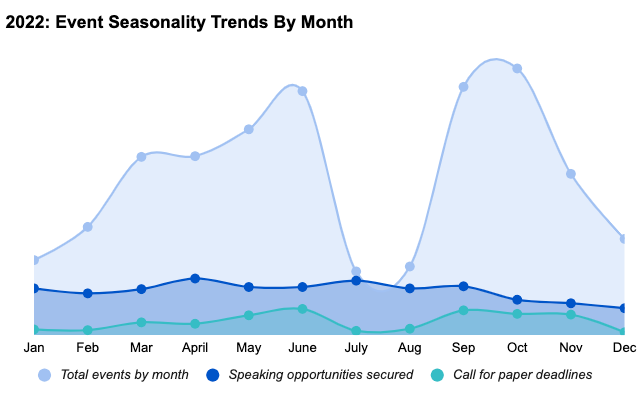At the start of each year, we take a look back at our events database to find insights and trends from the year before. While 2020-2021 impacted the way we plan, speak at, and attend conferences forever—2022 was the first time in a while things felt almost back to normal—or at least, a new type of normal.
How has event seasonality changed?
The event world is busy year-round, but there are periods when more events are happening, calls for papers running, and invitations being extended to speakers.
Rather than looking at seasonality trends year-over-year, let’s focus on the past 12 months and what we can expect moving forward. After all, the last few years experienced major ups and downs in events being organized, postponed, and canceled, driven by several COVID waves, regional shelter-in-place requirements, and travel restrictions.
Here is a snapshot of 2022 event seasonality trends by month—including events happening, call for paper deadlines closing, and speaking opportunities being secured.
By analyzing this data, we can discern the busiest times in the world of events and speaking. The first major spike is between March and June, and the second spike is from September through October. Remember when we said things were getting back to normal? These waves are very similar to the ones we saw in 2019 and the years prior.
The only category that doesn’t follow this trend is speaking opportunities secured. Even though events have a clear high and low season, cred sources thought leadership engagements for speakers consistently year-round.
What other trends are top of mind?
Drawing from lessons learned and trends from the past year, here are a few key trends that will impact how we approach speaking and events in 2023:
In-person events are the new normal again: In 2022, only about 1 in 4 events in our database were fully virtual, and even less were hybrid with a notable split of virtual and in-person components. In-person events are back and are showing no signs of slowing down. For example, the Consumer Electronics Show (CES), which wrapped earlier this month, ended with a total attendee count of more than 115,000, exceeding even the most optimistic projections.
Content changes: We've seen many topics related to COVID, remote work, etc., on agendas over the last few years. At this point, those topics have become stale, and instead, events are switching focus to more timely topics - like the economy, climate crisis, artificial intelligence, Web3, and more.
Broadening perspectives: Diversity, Equity, and Inclusion (DEI) is not a buzzword; event organizers continue to ask for a wide range of speakers and voices on their conference agendas. Take a critical look at your speaker bench and ensure all experts at your organizations are given opportunities to grow their thought leadership.
Budgets: In light of current market volatility, organizations across industries are being more conservative with budgets. This impacts event strategy on both sides of the table - the vendor side as well as the organizer side. What’s more, experts predict a cautious funding environment in 2023, further compounding the issue. Now, more than ever, it’s important to focus on earned speaking to get in front of the right audiences, in addition to existing paid strategies.
Interested in working with cred on your speaking program? Get in touch! Want to keep up with event trends like this? Sign up for our newsletter.


